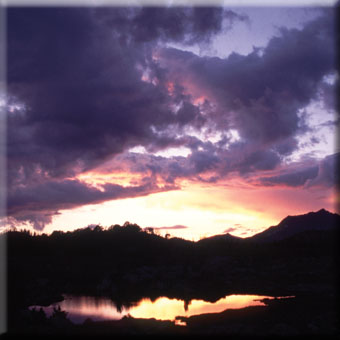Would you like a demonstration of the Catholic belief that everyone has a right to the beauty of God's creation? Visit a national park.
This October millions of Americans took a stay-cation by watching Ken Burns' gorgeous new film The National Parks: America's Best Idea, enjoying a 12-hour pilgrimage through some of the most beautiful places in the United States, perhaps on the planet.
From the comfort of our living rooms, Burns and co-producer Dayton Duncan led us on a grand tour of Yosemite, Yellowstone, Glacier, the Grand Canyon, the Everglades, and dozens of other national parks and monuments, showing us the majesty and splendor of these glorious places while regaling us with tales about some of the extraordinary folk-John Muir, George Masa, Marjory Stoneman Douglas, George Melendez, Stephen Mather-who helped preserve and protect these parks for all the rest of us.
Along with serving up the stunning beauty of these parks, Burns and Duncan argue that our national parks represent a uniquely American, democratic, and communitarian idea. In the creation and preservation of these parks, these two filmmakers see a national commitment to set aside our most sacred and nourishing places as a refuge for all Americans.
Burns argues that many of the places that have become our national parks "were the spiritual homes for the indigenous tribes who lived there" and have had "a profound and often spiritual effect" on settlers, visionaries, and visitors who have journeyed to them for rest and recreation.
Duncan adds that "these spectacular landscapes" have become our common treasure, belonging not just to monarchs and magnates, but to all of us. As Woody Guthrie would have said, these sacred parks are our parks.
Implicit in this argument is the notion that beauty itself ought to be shared among all our people, that the ideals of American democracy oblige us to protect everyone's right to enjoy the majesty and wonder of creation, to savor the beauty of national parks such as Zion, Bryce, or Olympic. The national parks exist on some level because we believe that all people are entitled to contemplate and be refreshed by the beauty of creation, that no one should be forced to spend their entire lives trapped in filth and squalor.
At the same time Burns and Duncan also argue that creating and protecting these oases of divine wonder and majesty was largely the work of big government, and that a strong federal hand was essential to preserving these places from two other deeply American notions: consumerism and individualism.
When naturalist and conservationist John Muir recoils at the degradation Niagara Falls suffers from excessive and unregulated commercialism, he turns to the government to help protect his Yosemite from a scourge of merchants. And when commercial logging companies threaten to strip the Great Smoky Mountains of much of their beauty, it is the government that steps in to preserve and protect these parklands.
With a chorus of voices decrying the evil of big government and federal bureaucrats, Burns and Duncan remind us how important government is in restraining the excesses of the free market.
Burns and Duncan may be right in arguing that the notions underlying the creation and preservation of the archipelago of national parks scattered throughout our country are distinctly American. But they are also profoundly Catholic sentiments.
The argument that all people, especially the poor and downtrodden, have a fundamental right to savor the majestic beauty of creation is deeply biblical and Catholic, while the notion that the wonders of creation are to be shared with all people is a key element of Catholic social teaching. And the argument that government has a critical role in preserving and protecting the common good against the corrosive forces of greed can be found in nearly every Catholic social encyclical since 1891.
The great liberation theologian Gustavo Gutierrez once argued that the world's poor must not be forced to become the garbage dump of the modern world, for they have a fundamental right to beauty, which is an essential element of their right to life. And a recent Vatican document on culture called upon the church to help create a humane environment for the world's poor, "for they too have a right to beauty."
This Catholic sentiment springs from the belief that all humans have a right to the contemplative and soul-nourishing rest provided by the savoring of beauty, and that no one-as Gutierrez argues-should be exiled to the world's refuse bins.
At the same time Catholic social teaching has long spoken of the "universal purpose of created goods," arguing that the bounty and beauty of creation is intended for the nurturing and support of all people. So while Catholic thought has long supported the right to private property, the goods of the earth are always to be arranged in a way that lets everyone get a fair share of what they need. The national parks are a wonderful example of this very principle.
And finally, Catholic social teaching has long affirmed the notions of subsidiarity and the common good, arguing that government plays a limited but essential role in protecting the rights of the poor and marginalized, a role that other groups are not capable of fulfilling.
As Pope Leo XIII wrote nearly 120 years ago, when the interests of the weak and poor are threatened, public authority must step in to address their needs. There is a job for government in Catholic thought, and creating and preserving places where ordinary people can savor God's majestic creation is one part of that job.
Writing of his youth in a British mining town, D. H. Lawrence complained that the "great crime which the moneyed classes and promoters of industry committed . . . was the condemning of workers to ugliness, ugliness, ugliness."
Burns and Duncan argue that the great blessing of the national parks was that it offers ordinary folks the blessings of beauty, beauty, beauty. And God saw that it was good.
This article appeared in the December 2009 issue of U.S. Catholic (Vol. 74, No. 12, page 40).
















Add comment